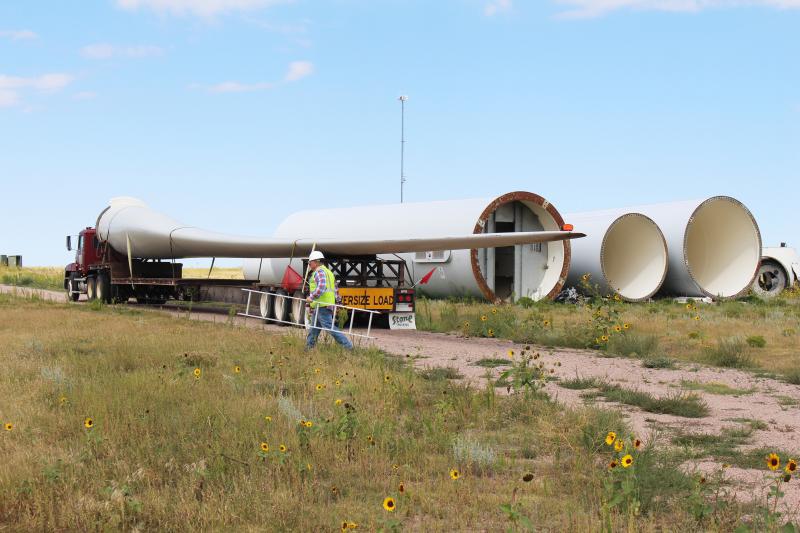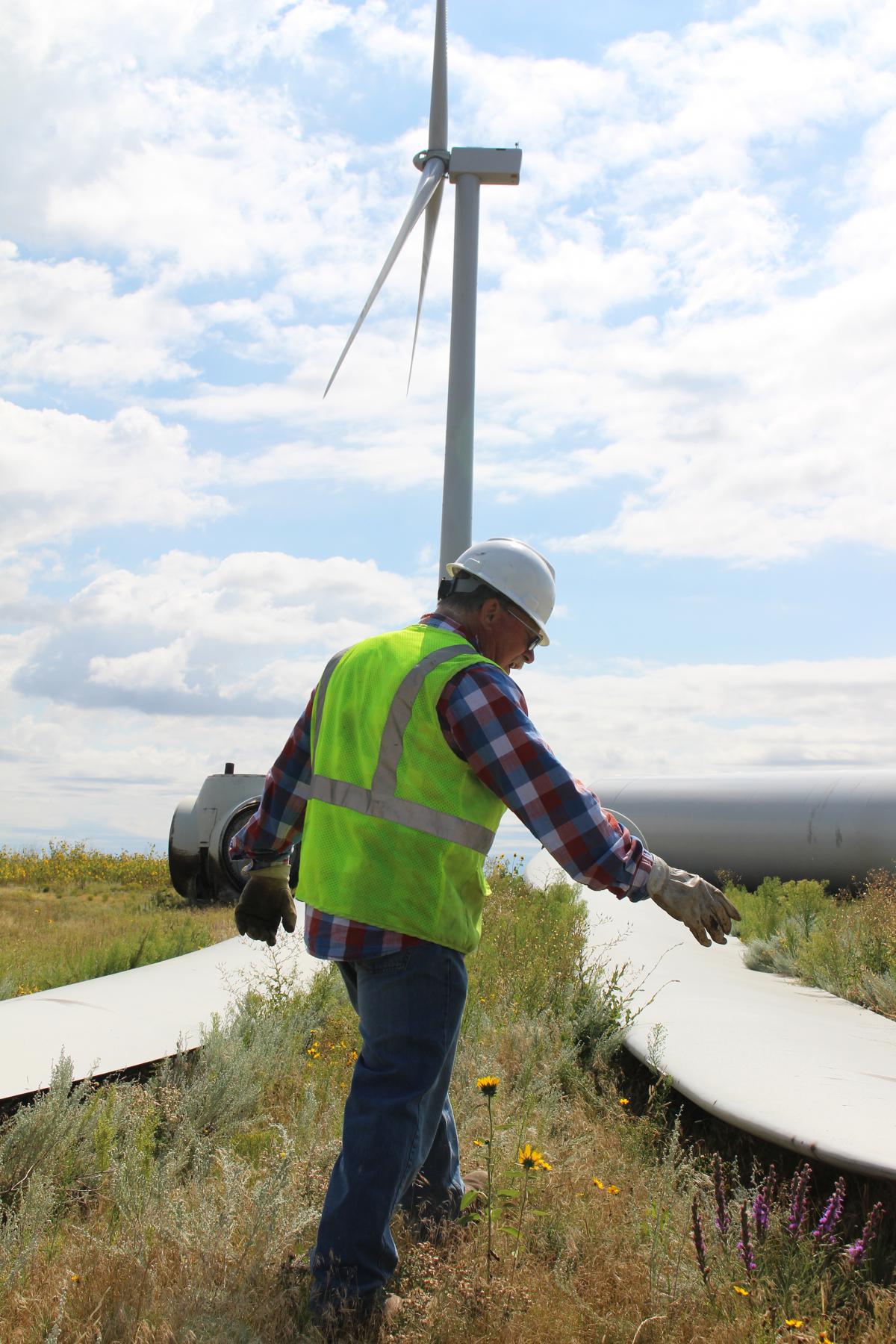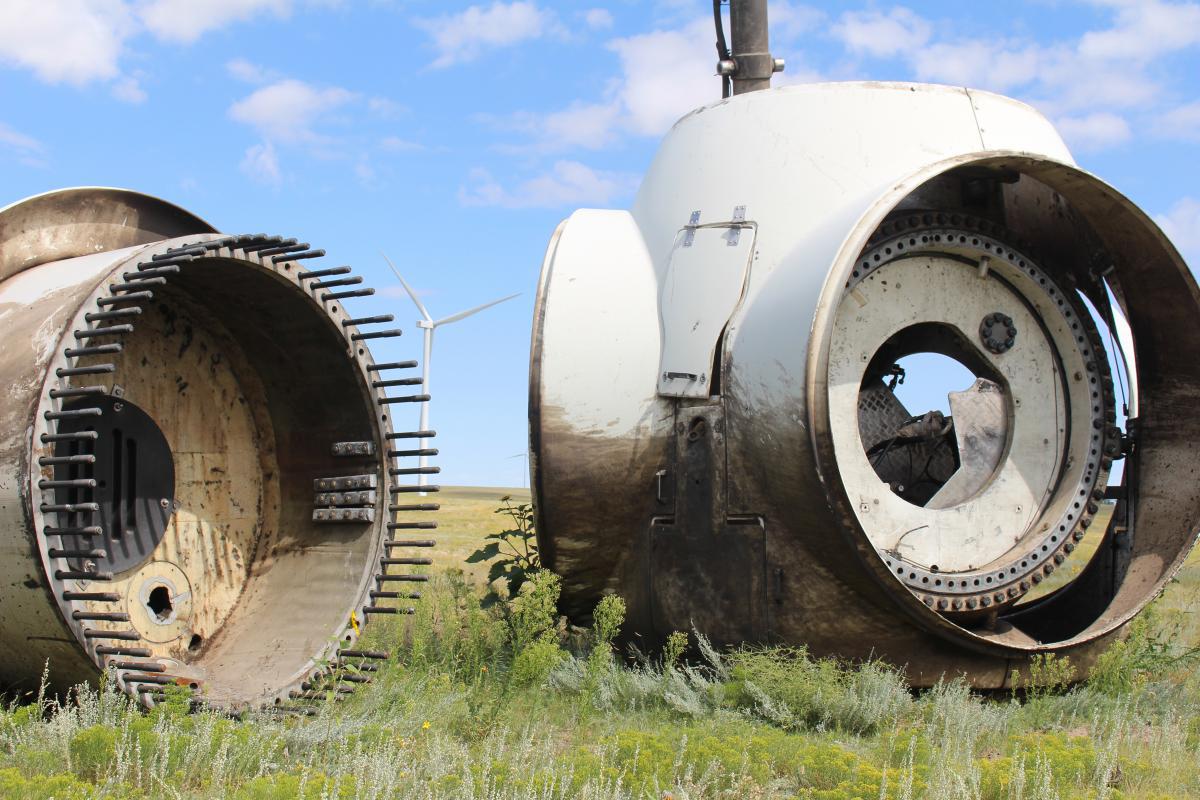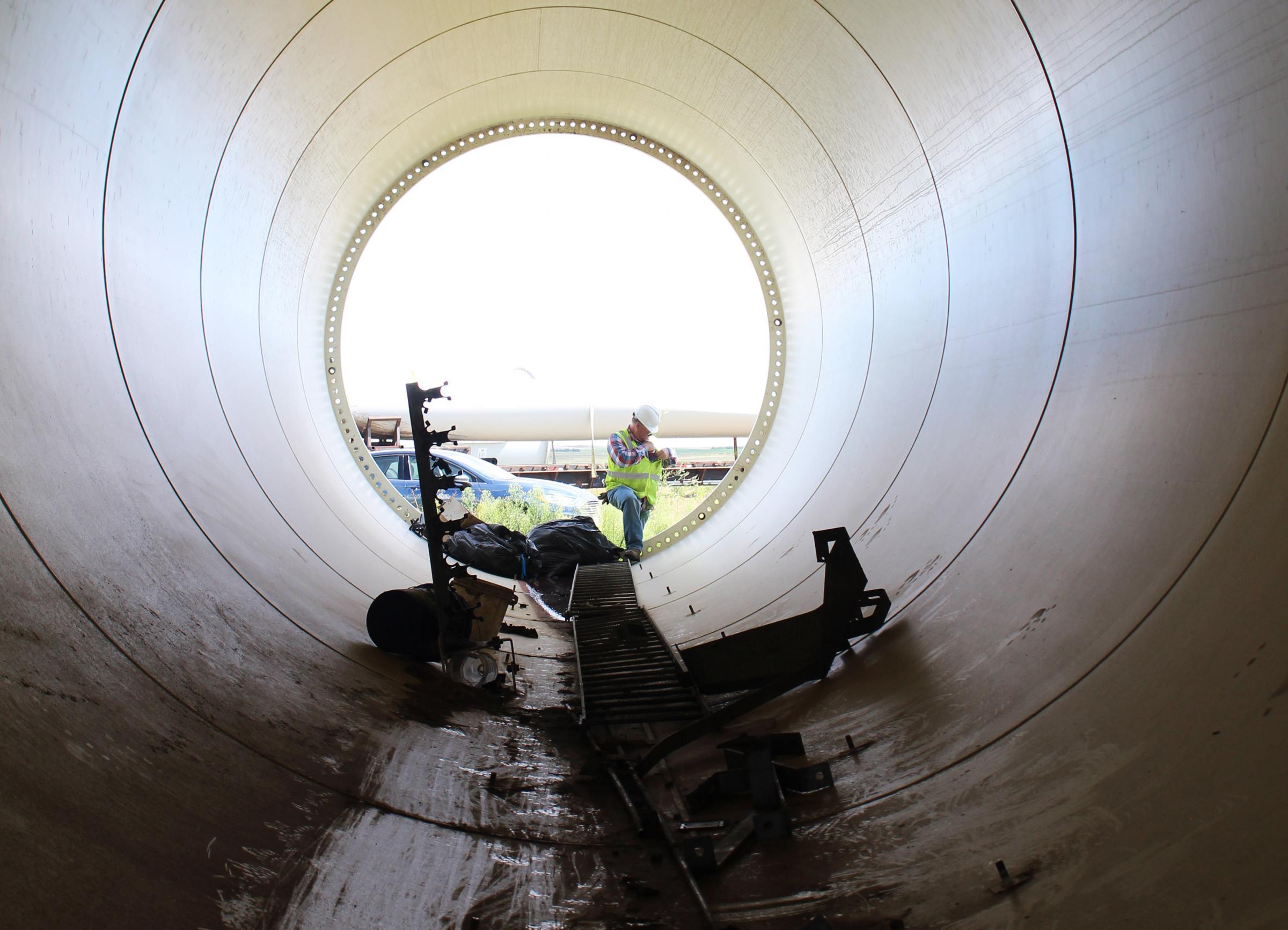Wind Turbines Leave Behind Hard-To-Manage Waste
5:33 minutes

 This segment is part of The State of Science, a series featuring science stories from public radio stations across the United States. Original reporting on this story by Christina Stella appeared on Harvest Public Media.
This segment is part of The State of Science, a series featuring science stories from public radio stations across the United States. Original reporting on this story by Christina Stella appeared on Harvest Public Media.
Over the last two years, Rob Van Vleet has been slowly scrapping the last vestiges of Kimball, Nebraska’s first wind farm. The wind turbines are made to be sturdy, he said, but they don’t last forever—about 20 years.
While most of a turbine can be recycled or find a second life on another wind farm, researchers estimate the U.S. will have more than 720,000 tons of blade material to dispose of over the next 20 years, a figure that doesn’t include newer, taller, higher-capacity versions.
There aren’t many options to recycle or trash blades, and what options there are is expensive, partly because the U.S. wind industry is so young. It’s a waste problem that runs counter to what the industry is held up to be: a perfect solution for environmentalists looking to combat climate change, an attractive investment for companies like Budweiser and Hormel Foods and a job creator across the Midwest and Great Plains.
At the end of a long gravel road on the southwest Nebraska prairie, the Kimball Wind Project is caught in the breeze. But the turbine scrap area looks more like a sci-fi drama set. Van Vleet climbed atop a 127-foot-long turbine blade, and walked the length like a plank.

“These towers may be supporting as much as 150,000 pounds, 250 feet in the air,” Van Vleet said. “The stands are an inch and a half thick steel… so they’re very strong.”
Van Vleet said 90 percent of a turbine’s parts can be recycled or sold. But the blades, made of a tough but pliable mix of resin and fiberglass—similar to what spaceship parts are made from—are a different story.
“The blades are kind of a dud because they have no value,” he said.
Decommissioned blades are also notoriously difficult and expensive to transport. They can be anywhere from 100 to 300 feet long, and need to be cut up onsite before getting trucked away on specialized equipment—which costs money—to the landfill.
Once there, Van Vleet said, the size of the blades can put landfills in a tough spot.
“If you’re small utility or municipality and all of a sudden hundreds of blades start coming to your landfill, you don’t want to use up your capacity for your local municipal trash for wind turbine blades,” he said, adding that permits for more landfill space adds another layer of expenses.
Cindy Langstrom manages the turbine blade disposal project for the municipal landfill in Casper, Wyoming. Though her landfill is one of the only ones in the state—not to mention the entire U.S.—with enough space to take wind farm waste, she said the blades’ durability initially posed a financial hurdle.
“Our crushing equipment is not big enough to crush them,” she said.
Langstrom’s team eventually settled on cutting up the blades into three pieces and stuffing the two smaller sections into the third, which was cheaper than renting stronger crushing machines that are usually made for mining.

Karl Englund, a researcher and chief technology officer of Global Fiberglass Solutions, said recycling turbine blades is more regulated in countries that have had wind power for decades. The European Union has waste management rules, so some European companies sell older parts to customers in Asian and Latin American countries.
“[In Europe], land is at a premium, and you’re not allowed to throw things away,” he said. “So you have to do it.”
Englund believes he’s found a way to recycle blades by grinding them up to make chocolate chip-sized pellets. They can be used for decking materials, pallets and piping. His startup opened its first processing facility in central Texas this year, and are leasing a second space near Des Moines, Iowa.

Van Vleet said finding better ways to decommission wind farms will be an uphill battle, but when it comes to confronting the looming waste issue, “it’s something that’s happening, whether we like it or not, so we just as well get in on it.”
He’s exploring his own way to decrease the industry’s landfill footprint, in the hopes that blade recycling can blossom into a local industry. And for rural areas looking for an economic boost, Van Vleet thinks his risk of recycling just might pay off.
“Out on the prairie, there’s not very much scrap,” he said. “The idea is to develop the next technology, otherwise, I wouldn’t be doing this.
“We lose money on every blade we haul.”
Christina Stella is a reporter for NET and Harvest Public Media in Lincoln, Nebraska.
IRA FLATOW: And now it’s time to check in on the state of science.
SPEAKER 1: This is KER–
SPEAKER 2: WWNO–
SPEAKER 3: St. Louis Public Radio.
SPEAKER 4: Iowa Public Radio News.
IRA FLATOW: Local science stories of national significance. If you’ve driven by a wind turbine, you’ve probably noticed that they are huge and getting bigger. They’re often several hundred feet tall, and the blades can be as tall as the Statue of Liberty. You heard me right.
So when a turbine is decommissioned, most of the parts can be recycled or reused, but not the blades. And this is causing a problem for wind farms and landfills. What happens to these giant turbines at the end of their lifespans? My next guest is here to tell us how the Midwest deals with discarded turbine blades. Christina Stella is a reporter for Harvest Public Media and NET– that’s Nebraska Educational Telecommunications– in Lincoln. Welcome, Christina.
CHRISTINA STELLA: Hey, Ira. Thanks for having me.
IRA FLATOW: You’re welcome. There’s a lot of wind energy developing happening in the Midwest. Tell us a little bit about what it’s like in Nebraska. There are lots of turbines going up there.
CHRISTINA STELLA: Well, I mean, a lot of states in the middle of the country have really been embracing wind development, especially over the last 10 years. But Nebraska has been a little slower on the uptake. So across our state, we’ve got about 1,000 turbines operating across 25 farms, and to give you a little context, that’s pretty low compared to our neighbors, like Kansas and Iowa, which each have between 3 and 5,000, Iowa having closer to 5,000 turbines.
IRA FLATOW: So as I mentioned, these turbines, they have these big blades on them. What are they made out of and what is the problem with the disposal of them after life?
CHRISTINA STELLA: Yeah, so the problem really is twofold, OK? They’re really strong, and they’re really big, which you already said. So turbine blades are made from a mix of resin and fiberglass. And so the resin is what makes them really durable, while the fiberglass gives them a little bit of bend, sort of like an airplane wing. So they’re really built to survive any kind of weather pattern. But–
IRA FLATOW: Go ahead. I’m sorry.
CHRISTINA STELLA: Go ahead. But what that means is that it takes really high powered equipment to break them down, and it costs a lot of money and energy to do that. So a lot of times, blades will just get cut up into three or so pieces and hauled off, and that poses quite a space issue for landfills.
IRA FLATOW: So there is really the– you have to have a special landfill to take them in, not just any landfill?
CHRISTINA STELLA: Yeah. I mean, a lot of municipal landfills are just not as interested in taking on wind projects, because they just create so much waste. To give you a sense of the size that the wind farm that I visited in Kimball Nebraska, one turbine blade was 127 feet long, and that’s an old model. These days, the blades are upwards of 300 feet long, and so if each turbine has three blades, and a farm can have tons of turbines, you can imagine how quickly that adds up at the landfill.
IRA FLATOW: I can. You talked to Rob Van Vleet, who is a scrapper in Nebraska, someone who disposes of these blades. And we have a clip from him.
ROB VAN VLEET: So if you’re a small utility or municipality, let’s say, and all of a sudden, hundreds of blades start to come to your landfill, you don’t want to use up your capacity for your local municipal trash for wind turbine blades.
IRA FLATOW: So what do they do then? What happens when a wind turbine is decommissioned? Are there any regulations for what to do with the blades?
CHRISTINA STELLA: Well, right now in the US, there’s actually no federal regulations for wind turbine disposal. I mean, a couple of states have adopted some policies requiring companies to provide what’s called an end of life plan. But a lot of the time, it’s really local governments asking for those plans as the farm is being developed. But the thing about those plans is that they don’t tend to include where the waste actually goes, just kind of how turbines will be taken down and how the land is going to be restored. So a lot of the time, they do end up just being taken to whatever landfills will accept them.
Now, in Europe, the EU has tightened their waste management guidelines really to try and force companies to divert wind turbine waste from landfills. And sometimes that looks like selling older parts to markets in Eastern Europe and Asia. But here, because the industry is still pretty young, we are still– and companies are still trying to answer that question and find a better solution.
IRA FLATOW: You did talk to a couple of people who are thinking of new ways of getting rid of these blades. I’m thinking of Cindy Langstrom in Casper and Karl Englund. Tell us about what they said.
CHRISTINA STELLA: So Cindy has actually established a special turbine blade disposal project, and in my story, she talked about how it was too expensive for them, really, to actually crush up the blades. And so she cuts them up into three pieces, and then she takes two of them and stuffs them into the third, and then they sort of store that at their landfill in Wyoming.
And Carl is actually– he’s worked on a process that involves grinding up the blades and then making something called a poly pellet out of them. He takes that material and mixes them with thermal plastics. And so you can make all kinds of cool stuff, like decking materials and piping and all that.
IRA FLATOW: Creative ways. We’re going to have to come up with some more of them. Thank you very much, Christina.
CHRISTINA STELLA: Thank you.
IRA FLATOW: Christina Stella, reporter NET and Harvest Public Media in Lincoln, Nebraska. We’re going to take a break. And when we come back, we’re going to talk about facial recognition I’m Ira Flatow. This is Science Friday from WNYC Studios.
Copyright © 2019 Science Friday Initiative. All rights reserved. Science Friday transcripts are produced on a tight deadline by 3Play Media. Fidelity to the original aired/published audio or video file might vary, and text might be updated or amended in the future. For the authoritative record of Science Friday’s programming, please visit the original aired/published recording. For terms of use and more information, visit our policies pages at http://www.sciencefriday.com/about/policies/
Alexa Lim was a senior producer for Science Friday. Her favorite stories involve space, sound, and strange animal discoveries.
Danya AbdelHameid is Science Friday’s fall 2019 narrative podcasting intern. She’s most interested in telling stories about the complex, messy ways that science interacts with culture, history, and society, but she’s really into glaciers and ice sheets, too.
Ira Flatow is the founder and host of Science Friday. His green thumb has revived many an office plant at death’s door.